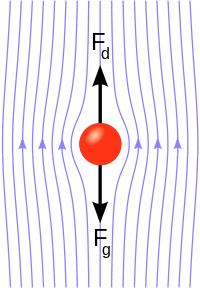
Photo from wikipedia
Abstract Driving oscillatory flow around an obstacle generates, due to inertial rectification, a steady ‘streaming’ flow that is useful in a host of microfluidic applications. While theory has focused largely… Click to show full abstract
Abstract Driving oscillatory flow around an obstacle generates, due to inertial rectification, a steady ‘streaming’ flow that is useful in a host of microfluidic applications. While theory has focused largely on two-dimensional flows, streaming in many practical microfluidic devices is three-dimensional due to confinement. We develop a three-dimensional streaming theory around an obstacle in a microchannel with a Hele-Shaw-like geometry, where one dimension (depth) is much shorter than the other two dimensions. Utilizing inertial lubrication theory, we demonstrate that the time-averaged streaming flow has a three-dimensional structure. Notably, the flow reverses direction across the depth of the channel, which is a feature not observed in less confined streaming set-ups. This feature is confirmed by our experiments of streaming around a cylinder sandwiched in a microchannel. Our theory also predicts that the streaming velocity decays as the inverse cube of the distance from the cylinder, faster than that expected from previous two-dimensional approaches. We verify this velocity decay quantitatively using particle tracking measurements from experiments of streaming around cylinders with different aspect ratios at different driving frequencies.
Journal Title: Journal of Fluid Mechanics
Year Published: 2022
Link to full text (if available)
Share on Social Media: Sign Up to like & get
recommendations!